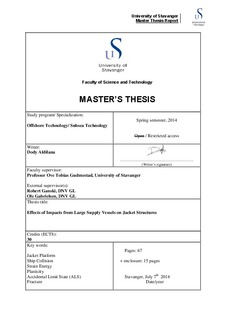| dc.contributor.author | Aldilana, Dody | |
| dc.date.accessioned | 2014-12-18T10:21:39Z | |
| dc.date.available | 2014-12-18T10:21:39Z | |
| dc.date.issued | 2014-07-02 | |
| dc.identifier.uri | http://hdl.handle.net/11250/227763 | |
| dc.description | Master's thesis in Offshore technology | nb_NO |
| dc.description.abstract | The current jacket structures installed on the Norwegian Continental Shelf (NCS) are designed to resist the impact energy from supply vessels with a 5000 tons displacement. This agrees with the requirement that is stated in NORSOK N-003. In addition to that, a minimum of 2 m/s ship velocity at collision accident is specified for the Accidental Limit State (ALS) in the early design phase.
However, during the last decade there has been a development of supply vessels sizes in terms of displacement. This means that collision with supply vessels with displacement more than 5000 tons may be expected nowadays and for the near future. This corresponds to higher impact energy which should be resisted by the jacket structures. In addition, the speed at impact may vary and there is a huge possibility that the speed is more than 2 m/s. For example, during the collision of Big Orange XVIII with Ekofisk 2/4 W platform, the reported speed at the time of impact was 9.3 knots, or equal to 4.8 m/s [Ref. /19]. This will result in higher impact energy than the anticipated in the early design phase.
In this thesis, four platforms are investigated in order to check their capacity against high impact energy. The analysis is based on a quasi-static nonlinear approach. A finite element computer program is used to simulate the impact scenarios. Various impact scenarios have been simulated in order to cover as much as possible the possibility of impact locations in a jacket platform.
For each impact scenario, the maximum energy absorption is limited either by fracture or denting of the hit member, or failure of the adjacent joints. As for the fracture limit criteria, the proposed values in NORSOK N-004 are used. | nb_NO |
| dc.language.iso | eng | nb_NO |
| dc.publisher | University of Stavanger, Norway | nb_NO |
| dc.relation.ispartofseries | Masteroppgave/UIS-TN-IKM/2014; | |
| dc.subject | offshore technology | nb_NO |
| dc.subject | offshore teknologi | nb_NO |
| dc.subject | undervannsteknologi | nb_NO |
| dc.title | Effects of impacts from large supply vessels on jacket structures | nb_NO |
| dc.type | Master thesis | nb_NO |
| dc.subject.nsi | VDP::Technology: 500::Marine technology: 580::Offshore technology: 581 | nb_NO |
